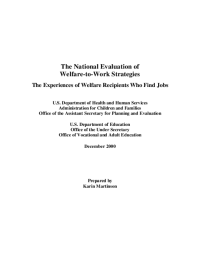The Experiences of Welfare Recipients Who Find Jobs
While much attention has been paid to efforts to help welfare recipients find jobs, policymakers and program administrators are increasingly focused on designing interventions that will help welfare recipients stay employed over the long-run. Past research has shown many welfare recipients have relatively unstable work patterns. While many do find work, some eventually lose their jobs and return to the welfare rolls. In addition, past experience indicates that most welfare recipients work in relatively low quality jobs with low wages, few benefits, and little opportunity for advancement. Because of time limits on the receipt of federal cash assistance through the Temporary Assistance for Needy Families (TANF) program, there is a new urgency to develop programs and policies that will help individuals find and keep jobs and stay off the rolls.
To help policymakers design programs that will help individuals sustain employment and potentially move up into better jobs, it is necessary to understand the general patterns of employment for welfare recipients who find jobs and what factors may be related to achieving success. Towards this end, this paper provides a description of the employment patterns of welfare recipients over a four-year follow-up period and the employment patterns and characteristics of those who are most and least successful in sustaining employment. This paper adds new insights into the employment patterns of welfare recipients because of unusually rich and detailed data sources on both the characteristics of individuals who find jobs, the type of jobs they obtain, and their overall employment patterns. It also has a relatively long follow-up period of up to four years and tracks a diverse range of welfare recipients.
MDRC is conducting the National Evaluation of Welfare-to-Work Strategies (NEWWS) under a contract with the U.S. Department of Health and Human Services (HHS), funded by HHS under a competitive award, Contract No. HHS-100-89-0030. Child Trends, as a subcontractor, is conducting the analyses of outcomes for young children (the Child Outcomes Study). HHS is also receiving funding for the evaluation from the U.S. Department of Education. The study of one of the sites in the evaluation, Riverside County (California), is also conducted under a contract from the California Department of Social Services (CDSS). CDSS, in turn, is receiving funding from the California State Job Training Coordinating Council, the California Department of Education, HHS, and the Ford Foundation. Additional funding to support the Child Outcomes Study portion of the evaluation is provided by the following foundations: the Foundation for Child Development, the William T. Grant Foundation, and an anonymous funder.
The findings and conclusions presented herein do not necessarily represent the official positions or policies of the funders.
To obtain other publications from the NEWWS Evaluation, go to aspe.hhs.gov/hsp/newws.







